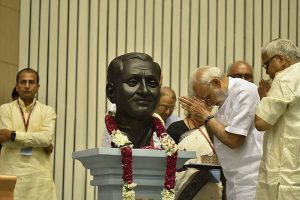Just before our attention almost uniformly turned toward the COVID-19 pandemic, a little-noticed event transpired in India. On February 16, 2020, Prime Minister Narendra Modi unveiled a 53-foot-tall statue of a long-gone politician, Deendayal Upadhyaya, in the city of Varanasi. While easy to miss in the flood of other news, this gesture still carried significant political symbolism.
Upadhyaya (1916-1968) was a leader of one of India’s main right-wing opposition parties, the Bharatiya Jana Sangh (BJS). While the BJS formally ceased to exist in 1977, having merged into a larger party, it was reborn in 1980 as the Bharatiya Janata Party (BJP) — the same party that has been ruling India since 2014. In a way, for the current generation of BJP’s leaders, Upadhyaya is an ideological grandfather, a role model in terms of building a certain narrative. The choice, in particular, of cultivating memories of Upadhyaya, out of a whole group of departed leaders, tells us important things about the way the BJP would like to be perceived today.
The construction of the statue was not a one-off event or a perfunctory gesture. Since coming to power six years ago, the BJP has named or renamed a number of institutions after Upadhyaya. These include the new Institute of Archeology, inaugurated in 2019 (complete with Upadhyaya’s statue and a museum devoted to him) and the Mughalsarai Junction railway station, renamed in 2018. It was near that station that Upadhyaya died in unclear circumstances, apparently murdered.
He was survived by a rather vague concept of Integral Humanism. Originally outlined by him at party meetings in 1964 and 1965, the concept acquired a written form when the leader’s April 1965 lectures where collected into a book bearing the same name: Integral Humanism. The BJP of today still calls it its official ideology.
While it was perhaps not concrete enough to actually brand an ideology, Integral Humanism was advertised as a concept of governance that would recognize the significance of all aspects of human existence. The Western systems, Upadhyaya claimed, did not pay attention to spirituality of man, having focused only on the material aspects. The leader thus presented Integral Humanism as a third way for India; in his book, he criticized both capitalism and socialism and stressed that his country must go its own way, with firm rooting in its own cultural values.
It does not take much, however, to notice that some of the author’s more-or-less-vague ideas were strongly inspired by Western solutions. Upadhyaya called, for instance, for the Indian state to guarantee free education and medical treatment to its citizens, as well as jobs for its workforce. At the same time he denounced centralization. More than a third way, Integral Humanism appeared as the “middle way,” an approach that would steal the best elements from socialism and mix them with the party’s trademark Hindu religious nationalism.
Integral Humanism was a child of its times. It was formulated when the BJS was at a crossroads, struggling to find a good place in India’s then-volatile political environment. Socialism was much more popular, and an outspokenly socialist party – the Indian National Congress – was in charge. The BJS was in need of allies and striving to compete with another party of the right, the Swatantra Party. Thus, Integral Humanism was an attempt to jump in all directions at the same time: to steal the Swatantra Party’s thunder, to appear liberal to prospective allies, and to borrow socialist ideas to attract large sways of the electorate.
The Indian politics of today has changed a lot since the 1960s. It is the party of the right, the BJP, that is dominant and no longer being challenged by any rival on its side of the spectrum while left parties are mostly in disarray. But some parts of Integral Humanism are still useful in the same way as they were before. First, for Indian parties select socialist ideas — whether in practice or only rhetorically — are still one of the main ways to attract poorer voters.
Second and equally important, Integral Humanism may make the party look much more liberal than its nationalist practice suggests. For instance throughout his book Upadhyaya used the neutral adjective “Bharatiya” (Indian), instead of “Hindu.” He wrote, for instance, of “Bharatiya values.” The politician also declared a reformist goal while stressing the significance of traditions. “We have taken due of our ancient culture. But we are no archaeologists […] Our goal is not merely to protect the culture but to revitalize it to make it in tune with the times,” he wrote.
It is no surprise that the BJP of today mentions Upadhyaya many times more often than the other BJS leader of 1960s – and Upadhyaya’s rival – Balraj Madhok, who spoke the language of religious nationalism in a much more clear way. At the same time, however, Upadhyaya did not reject the Hindu religion either – far from it. In the same book he also stressed, using adroit semantic tactics, that India cannot be a secular state. After all, in his other writings and lectures Upadhyaya did not shy away from uttering the term “Hindu”; it is just that he used it less and more carefully than Madhok.
Integral Humanism was thus a catch-all. It was formulated to make the party combine different ideologies at the same time: socialist and right-wing, spiritual and progressive, liberal and nationalist.
It may be argued that in the right-dominated political landscape of the 2020s, the BJP, with its electoral and financial edge over all rivals, does not need such rhetorical maneuvers as much. It is as powerful today as the BJS was weak in 1960s. But the fact that the party raises Upadhyaya to literal pedestals indicates that despite its currently outspoken Hindu nationalist course, the party still wants to be perceived as more liberal in the long run.

































